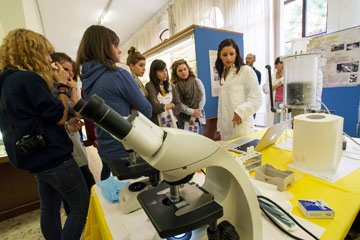- Authors:
-
Negrisolo, Enrico; Kuhl, Heiner; Forcato, Claudio; Vitulo, Nicola; Reinhardt, Richard; Patarnello, Tomaso; Bargelloni, Luca
- Title:
-
Different phylogenomic approaches to resolve the evolutionary relationships among model fish species
- Year:
-
2010
- Type of item:
-
Articolo in Rivista
- Tipologia ANVUR:
- Articolo su rivista
- Language:
-
Inglese
- Referee:
-
No
- Name of journal:
- MOLECULAR BIOLOGY AND EVOLUTION
- ISSN of journal:
- 1537-1719
- N° Volume:
-
27
- Number or Folder:
-
12
- Page numbers:
-
2757-2774
- Keyword:
-
Animals; Biological Evolution; Chromosome Painting; Comparative Genomic Hybridization; Genomics; Mutation; Oryzias; Sequence Alignment; Takifugu; Zebrafish; Evolution, Molecular; Phylogeny
- Short description of contents:
- Comparative genomics holds the promise to magnify the information obtained from individual genome sequencing projects, revealing common features conserved across genomes and identifying lineage-specific characteristics. To implement such a comparative approach, a robust phylogenetic framework is required to accurately reconstruct evolution at the genome level. Among vertebrate taxa, teleosts represent the second best characterized group, with high-quality draft genome sequences for five model species (Danio rerio, Gasterosteus aculeatus, Oryzias latipes, Takifugu rubripes, and Tetraodon nigroviridis), and several others are in the finishing lane. However, the relationships among the acanthomorph teleost model fishes remain an unresolved taxonomic issue. Here, a genomic region spanning over 1.2 million base pairs was sequenced in the teleost fish Dicentrarchus labrax. Together with genomic data available for the above fish models, the new sequence was used to identify unique orthologous genomic regions shared across all target taxa. Different strategies were applied to produce robust multiple gene and genomic alignments spanning from 11,802 to 186,474 amino acid/nucleotide positions. Ten data sets were analyzed according to Bayesian inference, maximum likelihood, maximum parsimony, and neighbor joining methods. Extensive analyses were performed to explore the influence of several factors (e.g., alignment methodology, substitution model, data set partitions, and long-branch attraction) on the tree topology. Although a general consensus was observed for a closer relationship between G. aculeatus (Gasterosteidae) and Di. labrax (Moronidae) with the atherinomorph O. latipes (Beloniformes) sister taxon of this clade, with the tetraodontiform group Ta. rubripes and Te. nigroviridis (Tetraodontiformes) representing a more distantly related taxon among acanthomorph model fish species, conflicting results were obtained between data sets and methods, especially with respect to the choice of alignment methodology applied to noncoding parts of the genomic region under study. This may limit the use of intergenic/noncoding sequences in phylogenomics until more robust alignment algorithms are developed.
- Product ID:
-
94670
- Handle IRIS:
-
11562/953514
- Last Modified:
-
November 18, 2022
- Bibliographic citation:
-
Negrisolo, Enrico; Kuhl, Heiner; Forcato, Claudio; Vitulo, Nicola; Reinhardt, Richard; Patarnello, Tomaso; Bargelloni, Luca,
Different phylogenomic approaches to resolve the evolutionary relationships among model fish species
«MOLECULAR BIOLOGY AND EVOLUTION»
, vol.
27
, n.
12
,
2010
,
pp. 2757-2774
Consulta la scheda completa presente nel
repository istituzionale della Ricerca di Ateneo 








